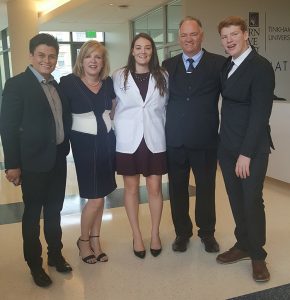Keratonconus Journey: Max

“Just” a Routine Visit to the Eye Doctor
Max was just a typical 15-year-old from Columbus, Ohio when his eye health changed forever. It started with a routine optometrist visit with his older sister, Morgan, to pick up a new prescription for contact lenses. During his eye exam, the doctor became concerned that the shape of Max’s cornea was changing and referred him to the local hospital for further evaluation.
During the second assessment, Max underwent a series of corneal tests that monitor for vision problems and was diagnosed with keratoconus or ‘KC’. His warning signs for keratoconus were slight annoyances that Max had grown used to seeing. As someone who had always worn glasses, he assumed the scratches he saw were actually on his lenses. Now, Max learned that the blemishes he noticed were a result of keratoconus.
Initially, Max wore contacts and soft lenses, which helped his vision, but after speaking with his optometrist he understood that his eyesight was only going to get worse. At the same time Max’s mother, Sandy, and father, Jim, were reading any and all information they could find on the condition and found long-term treatment options available in the U.S. for their son.
The doctor confirmed that Max would not be a candidate for a corneal transplant until his eyesight had deteriorated to the point where his vision was significantly impaired. His only option at this point was watch and wait.
From there, the whole family was left with a series of questions. How fast would Max’s vision deteriorate? Would he be able to take his driver’s test as scheduled in the next year? How would this impact his future and his eventual career? And most distressing, would Max go blind someday, perhaps even soon?
A Transformative Uber Ride

While on vacation in Florida six months after Max’s diagnosis, his family had a chance encounter that reshaped how the family would treat Max’s keratoconus. During a shared Uber ride from the grocery store back to the hotel, Max’s mom, Sandy, found herself seated next to a keratoconus specialist, who also happened to be from Columbus, Ohio. Not only that, but the doctor was staying at their hotel and attending a keratoconus seminar that was being held in the same location. In a wonderful twist of fate, the doctor had just learned about the then newly FDA-approved cross-linking procedure to stop the progression of keratoconus. Following the Uber ride, the specialist gave Sandy the information for a physician in Columbus, Ohio who was offering the latest treatment for keratoconus.
In October, a couple of months after their vacation, Sandy, Jim, and Max connected with the ophthalmologist to learn more about cross-linking to treat his progressing keratoconus. They found out that the procedure was intended to halt or slow the visual deterioration caused by the disease and were cautioned that if they chose to “watch and wait,” Max might eventually need a corneal transplant in the future.
That fall, Max was one of the first people in Ohio to undergo corneal cross-linking, as the FDA-approved procedure had only recently become available. Max’s left eye was treated first since it had progressed further than his right eye. Three months later (January 2017), Max’s right eye was treated. The results of the treatments and recovery period surpassed Max’s expectations, as he was able to return to school and his everyday life fairly quickly.
Living Life as a Normal Teenager with KC
Aside from his keratoconus diagnosis, Max is living life as a normal 16-year-old. He plays in a band and sings in an acapella group. Max says that the best thing about his decision to undergo cross-linking is his peace of mind. His disease has not progressed since he had the procedure and he hopes that the possibility of needing a corneal transplant is in the past.
For her part, Sandy is thankful to have met a keratoconus specialist on that fateful Uber ride which ultimately led to the cross-linking procedure. Before learning about the treatment, Sandy was constantly worried about Max and his future. Now, Sandy rarely thinks about the potential impact keratoconus could have had on Max’s vision and feels an enormous weight has been lifted off her shoulders.
Click to read more KC Journeys.
The results described on this site are based on data collected regarding short- and intermediate-term efficacy of treatment. Individual results are not guaranteed and may vary.